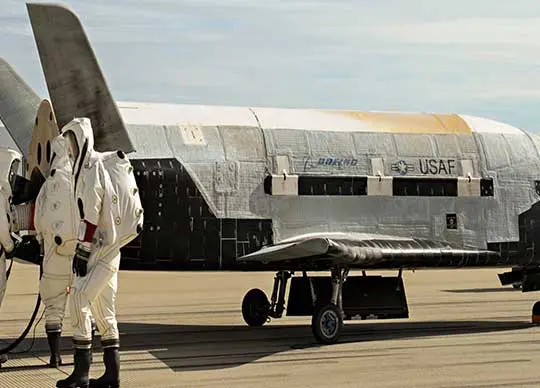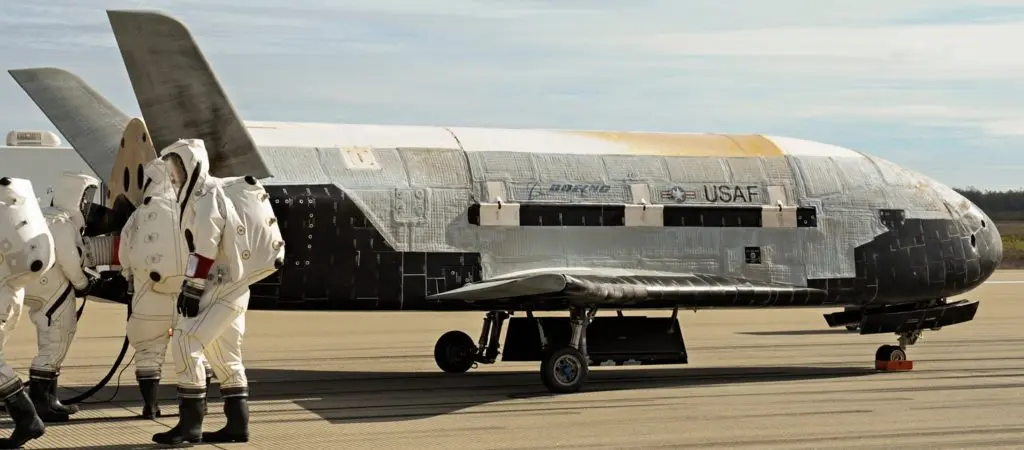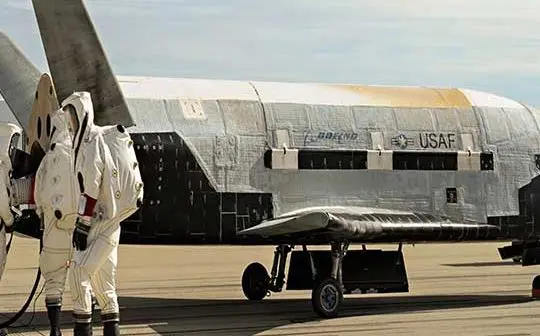
By Chris Flaherty
My Space Warfare Analysis Lab
INTRODUCTION
Core Strategic Functioning Satellites are likely to be large, old and fragile, vulnerable and expensive, and will continued to be relied upon by countries like the United States for the next decade. Past ASAT tests using kinetic strike, have proved these craft if hit will shatter into a myriad of pieces crating a debris cloud, and multiple shrapnel vectors that threaten other nearby Space Infrastructure. Future satellites are anticipated to be military constellations using resilient architecture. These will be robust, and hardened to withstand a kinetic attack, as well as Laser, Cyber and Electronic Warfare assaults. Satellites are expected to be upgraded and replaced with newer versions, part of a capacity build-up creating cluster-constellations, that allow functions to be exchanged (in a type of Space shell-game with a potential adversary). Until this process happens, the basic strategic-tactical problem will be: how to protect the Core Strategic Functioning Satellites from attack, capture or interference? The Bodyguard Spacecraft concept has been enunciated as one of the main technology directions.
BODYGUARD SPACECRAFT DESIGN
It is envisaged that a Space Force will maintain a Space Fleet of Bodyguard Spacecraft, whose role is to manoeuvre into a guardian position in relation to a satellite that needs to be defended. Creating a Bodyguard Spacecraft sits within a dynamic range of current and future Space vehicles development categories, that have largely diverged into one of four archetypes.
Currently, we tend to make a distinction between four different types of Space vehicles ►
- Space Station
- Satellite
- Spacecraft
- Spaceplane
A Bodyguard Spacecraft will remain uncrewed, be Ground Controlled, and operate both as an orbiting satellite, but also as a manoeuvring Spacecraft. Experimental craft like the Robotic Boeing X-37B Spaceplane, have also been suggested could be used in a Bodyguard Spacecraft role in Low Earth Orbit scenarios, in addition to actual Bodyguard Spacecraft development.

The Chinese Kinetic Impactor, mated with the upper (second) stage of the Long March 5 (CZ-5) Rocket. Shown here in its launch configuration, with its fairing nose cone (South China Morning Post/China National Space Administration Photo-Handout, 2021). This craft is designed for Asteroid interdiction. The concept of an upper (second) stage remaining attached to a weapons satellite, giving it greater propulsion, combined with additional thrusters for orbital manoeuvre gives an impression of a typical Bodyguard Spacecraft in the near future.
There is growing recognition of the future importance of the Spacecraft-Satellite; a weaponized satellite, with a high-level of manoeuvre, as it has a propulsion engine, and high fuel load (high Delta-V), and it can be regularly refuelled, and serviced in Space. This type of craft is central to the United States Space Force concept of warfare (U.S. Space Force, 2020). In the near-future there will be a transition to Bodyguard Spacecraft on station with high-level manoeuvrability pre-positioned to protect high-value military satellites. Pre-positioning is essential given that orbital mechanics do not allow for last-minute launches or manoeuvres (Chow, 2019; 2020).
Robotic Servicing Spacecraft (robotic mechanics that can repair or upgrade friendly satellites in orbit), and Killer Robotic Spacecraft are largely derived from the same basic rendezvous and robotic capabilities technologies. These can be the Attacking Enemy Spacecraft or the Bodyguard Spacecraft in future Space Warfare scenarios. The basic concept of a Bodyguard Spacecraft, is these will be stationed near satellites that need protection. The Bodyguard Spacecraft concept is largely a technological solution, that is mated with a political-diplomatic one – the concept of the Space Safety Zone (discussed later in this paper).

▲ Robotic Boeing X-37B Spaceplane (Boeing, 2014).
Future Bodyguard Spacecraft may have characteristics, such as being part of an upper (second) stage vehicle. It will have a propulsion unit with large capacity fuel tank (this will allow it to maintain its fuel reserves), and fitted with manoeuvring thrusters. It will be designed for Space-docking with service craft. This will allow it to be refuelled, given repairs, get upgrades and replacements. It will be hardened against attacks, and against the Space environment (in particular being struck by natural objects and debris). The Bodyguard Spacecraft represents the first generation of a Space Force’s Space Fleet. The concept also brings to fruition Space Manoeuvre to a much greater level of capacity than currently envisaged.
SPACE MANOEUVRE
The future concept of Space Warfare is one based on the concept of constant manoeuvre during orbit. However, our current concept of Space Manoeuvre is restricted to a satellites Delta-V; which in its simplest form, is the amount of reserve fuel it carries for orbital changes, or simply being able to perform adjustments in order to maintain its orbital position. A more sophisticated concept of Space Manoeuvre is a craft that can move from one orbit to another, and can rendezvous with another object in Space. An extension of this, is the craft’s capacity to adjust its position to evade a collision.
The Bodyguard Spacecraft as a next stage in development has the capacity to track, rendezvous, block or interpose itself between the satellite it is guarding against and an Attacking Enemy Spacecraft on a potential collision course. It is envisaged that the Bodyguard Spacecraft will carry armaments such as Lasers, as well as Cyber and Electronic Warfare generating capabilities to disable an Enemy Craft. That Enemy Craft can be another orbiting satellite, it could be a Robotic Spaceplane, or could be an ASAT: a missile fired from the Ground into Space. Representing one spectrum of attacks. It could also be a Ground-Based Laser that shifts its frequency from a tracking beam, to a beam able to dazzle, blind or burn-out a satellite.
A SATELLITE’S SPACE SAFETY ZONE
Currently a belligerent can station Killer Spacecraft arbitrarily close to another country’s satellites. The Killer Spacecraft can then await command to attack with little warning. The Bodyguard Spacecraft is a concept for a new type of Space Force craft, whose function is to act as an escort Spacecraft to protect a critical satellite, preventing an invading, or Attacking Enemy Spacecraft from reaching and disabling a satellite. An integral component of the concept is the notion of a Space Safety Zone, that can be made-out around a critical but vulnerable satellite. It has been suggested that this could be a minimum safe distance of some 50 kilometres at geosynchronous orbits.
The Space Safety Zone, it is argued would come into existence as internationally agreed, or between the United States and a coalition of countries, to a three dimensional area of Space around the satellite, that another craft cannot infringe without permission. Entry into the Zone, without permission, would be called-out internationally as a violation – which given suitable Ground Control monitoring, would be observable and verifiable. The question becomes what type of defence can be initiated, by a country, in order to protect its satellite. The Bodyguard Spacecraft would operate within the Zone to protect the nearby satellite.
ATTACK AND SPACE PASSIVE DEFENCE STRATEGY
Currently, an Attacking Enemy Spacecraft can make one of four attacks on a satellite ►
- Physical Contact: Grab a Satellite
- Electronic: Laser
- Cyber
- Kinetic Strike
To dissuade an Attacking Enemy Spacecraft from entering a Satellite’s Space Safety Zone a Bodyguard Spacecraft (located within the Zone) can be used to interdict it, interposing itself between the attacker, and the target, or disabling the attacker once it enters the Zone. As a prelude to an intervention, a Bodyguard Spacecraft would have specific Rules of Engagement. Such as it would ‘announce to the world that an invader is in our zone and that it must leave immediately.’ (Chow, 2019; 2020) The next set of steps, are to use an impactor to gently nudge the attacker away, or to block its progress – this presumes that a Bodyguard Spacecraft would be sufficiently robust, or have a shell/surface designed to absorb Space collisions with another craft. The object being to do no harm to the invader, and ‘push it out of the Zone without hurting it.’ (Chow, 2019; 2020)
SPACE ESCALATORY STRATEGIES
Effectively, a Space Passive Defence Strategy, is advocated. This has two parts: (1) Its political-diplomatic aspects (the set-up of Space Safety Zones agreements); and, (2) Using Bodyguard Spacecraft technology. Viewed from the paradigm of escalatory strategies, the most passive form of defence in Space involves:
“target satellites performing evasive manoeuvring, satellite hardening, and using resilient architecture for new satellite constellations, are far less escalatory than active defences such as Bodyguard Spacecraft to prevent robotic ASATs from reaching our critical satellites.” (Chow, 2019)
Until new generation satellites come online, the problem remains – reliance on vulnerable, large, expensive and few-in-number legacy satellites, which the United States will continue to rely on at least during the 2020s (Chow, 2019). Use of Bodyguard Spacecraft in a Space Passive Defence Strategy, while having aggressive aspects, it nevertheless does not aim to destroy an Attacking Enemy Spacecraft, ‘but to gently push offending satellites far enough away that they no longer violate agreed Space Safety Zones.’ (Chow, 2019; 2020) A Bodyguard Spacecraft can be armed; however, its Laser, Cyber and Electronic Warfare capabilities are dialled-down operating only to temporarily disable an Enemy Craft.
A fundamental aspect of a Space Passive Defence Strategy is its escalatory aspect. For instance, interference with surveillance-reconnaissance satellites dedicated to early warning have had the understanding, it could trigger a nuclear counter-strike. This has been so fundamental to the use of Early Warning Satellites; these have featured in international treaty arrangements:
“The Accident Measures Agreement of 1971 and the Prevention of Nuclear War Agreement of 1973 together obligate the Soviet Union and the United States to refrain from interfering with or attacking early warning systems of either side, which would include satellites that are components of such warnings systems.” (Bosco, 1990)
The argument being, if a first launch was to occur, a blinding of the surveillance-reconnaissance satellites (early warning) would be expected. So if a country was to interfere with one, then a counter-strike (effectively an anticipatory attack was justified).
Other forms of escalation can also be identified. To this day, in Space Warfare escalation theory systems like the GPS, or international common use satellites used for economic and communications are largely out of bounds, due to the global effect that could be had if attacked – effectively escalating a conflict between two belligerents into a global affair.
AUTHOR
Chris Flaherty is a Space & Defense Tech and Security News Regular Contributor.
REFERENCES
- Boeing Corporation. 2014 Photograph. X-37B Orbital Reusable Spaceplane. Landed at Vandenberg Air Force Base (17 October).
- Bosco, J.A. 1990 International Law Regarding Outer Space – An Overview. Journal of Air Law and Commerce. Volume 55. Issue 3.
- Chow, B.G. Weeden, B. (Transcription: Green, J. Klein, R. Marban, A. Wake Forest Debate) 2020 Securing Our Military Satellites Against Shadowing Spacecraft. Transcript of a Discussion between Dr. Brian Chow and Dr. Brian Weeden on Space Zones and Bodyguards for Proximity Operations. Moderated by Henry Sokolski. Panel II of a Space Policy Workshop Co-sponsored by the Nonproliferation Policy Education Center and the American Bar Association Standing Committee on Law and National Security. NPolicy (2 March).
- Chow, B.G. 2019 Two Ways to Ward off Killer Spacecraft: One is diplomatic; the other, technological. Defense One (30 July).
- Chow, B.G. 2019 Op-Ed. Applying Weeden’s ‘Real Talk and Real Solutions’ to Real Space Robotic Threats. Space News (2 January).
- Crockett, J.W. 2012 Space Warfare in the Here and Now: The Rules of Engagement for U.S. Weaponized Satellites in the Current Legal Space Regime. Journal of Air Law and Commerce. Volume 77. Issue 4.
- Sokolski, H.D. (Series Editor) 2021 China Waging War in Space: An After-Action Report. Nonproliferation Policy Education Center. Occasional Paper 2104 (August).
- South China Morning Post/China National Space Administration. 2021. The So-Called Assembled Kinetic Impactor within China’s Long March 5 (CZ-5) Rocket. Photo-Handout.
- S. Space Force [Headquarters United States Space Force]. 2020 Space Capstone Publication, Spacepower (June).





